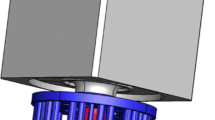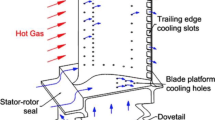Abstract
The accurate description and flow calibration at the exit of a gas turbine combustor is a key point of turbine design. Indeed, the temperature field at the turbine inlet directly impacts both the work extraction by the turbine stages as well as drives the wall heat transfer occurring on the vanes and rotor surfaces. Properly simulating or measuring this critical planar interface has been an extensive topic of research. Despite such efforts, industrial exploitation of the various measures at that interface usually resumes to a quantification of the temperature heterogeneities through the Local Radial Temperature Distortion Factor (LRTDF), thereby loosing major spatial and unsteady information. As lean burn configurations become a standard for aero-engine combustors, the absence of dilution holes reduces the intensity of mixing and the use of more advanced statistical tools should propose an exhaustive representation of the temperature map and mixing quality. Current state-of-the-art numerical design of gas turbine combustor relies on Large Eddy Simulations (LES) giving access to a fully 3-D temporally dependent flow field throughout the combustion chamber. Going beyond LRTDF is therefore possible and advanced analyses of the combustor-turbine interface are accessible to better qualify proposed design changes. In this work, a simple statistical representation of the temperature distribution is introduced and applied for the analysis of a lean burn combustor simulator interface. It is shown that at the exit of this chamber, the temperature samples are distributed following a non-Gaussian shape, highlighting a most probable local temperature largely different from the conventional mean value. The use of high order moments explains such deviations and indicates the presence of strongly segregated zones governed by the technological implementation of effusion cooling systems. Based on this diagnostic, a new and complementary representation of the LRTDF is proposed, accounting for the statistical dimension of the classical (radius, temperature) formulation.
Similar content being viewed by others
References
Povey, T., Chana, K.S., Jones, T.V., Hurrion, J.: The effect of hot-streaks on hp vane surface and endwall heat transfer: An experimental and numerical study. J. Turbomach. 129(1), 32–43 (2007)
Salvadori, S., Giovanni, R., Insinna, M., Martelli, F.: Analysis of combustor/vane interaction with decoupled and loosely coupled approaches. In: ASME Turbo Expo 2012: Turbine Technical Conference and Exposition, no. GT2012-69038, ASME (2012)
Insinna, M., Griffini, D., Salvadori, S., Martelli, F.: Conjugate heat transfer analysis of a film cooled high-pressure turbine vane under realistic combustor exit flow conditions. In: ASME Turbo Expo 2014: Turbine Technical Conference and Exposition, no. GT2014-25280 (2014)
Shang, T., Epstein, A.: Analysis of hot streak effects on turbine rotor heat load. J. Turbomach. 119(3), 544–553 (1997)
Roback, R.J., Dring, R.P.: Hot streaks and phantom cooling in a turbine rotor passage: Part 1—separate effects. J. Turbomach. 115(4), 657–666 (1993)
Ireland, P.T., Dailey, G.: Aerothermal performance of internal cooling systems in turbomachines.. In: Internal Cooling in Turbomachinery, VKI Lecture Series, Vol. 2010-05 (2010)
Sagaut, P.: Large Eddy Simulation for Incompressible Flows: An Introduction, Scientific Computation. Springer (2006)
Gicquel, L.Y.M., Gourdain, N., Boussuge, J.-F., Deniau, H., Staffelbach, G., Wolf, P., Poinsot, T.: High performance parallel computing of flows in complex geometries. Comptes Rendus de l’Académie des Sciences - Mathématiques 339, 104–124 (2011)
Gicquel, L.Y.M., Staffelbach, G., Poinsot, T.J.: Large Eddy Simualtions of gaseous flames in gas turbine combustion chambers. Prog. Energy Combust. Sci. 38, 782–817 (2012)
Povey, T., Qureshi, I.: Developments in hot-streak simulators for turbine testing. J. Turbomach. 131(3), 1–15 (2009)
Mendel, J.: Lessons in Estimation Theory for Signal Processing, Communications, and Control, Pearson Education (1995)
Dekking, F.M.: A modern introduction to probability and statistics: Understanding why and how. Springer (2005)
Sagaut, P., Cambon, C.: Homogeneous Turbulence Dynamics. Cambridge University Press (2008)
Pope, S.: Turbulent Flows. Cambridge University Press, Cambridge (2000)
Girimaji, S.S.: Assumed β-pdf model for turbulent mixing: Validation and extension to multiple scalar mixing. Combust. Sci. Technol. 78(4-6), 177–196 (1991)
Gaffney Jr, R.L., White, J.A., Girimaji, S.S., Drummond, J.P.: Modeling temperature and species fluctuations in turbulent, reacting flow. Comput. Syst. Eng. 5 (2), 117–133 (1994)
Bakosi, J., Ristorcelli, J.R.: Exploring the beta distribution in variable-density turbulent mixing. J. Turbul. 11(37), 1–31 (2010)
Joanes, D.N., Gill, C.A.: Comparing measures of sample skewness and kurtosis, Journal of the Royal Statistical Society. Series D (The Statistician) 47(1), 183–189 (1998)
Dorić, D., Nikolić-Dorić, E., Jevremović, V., Malisić, J.: On measuring skewness and kurtosis. Qual Quant 43(3), 481–493 (2009)
Balanda, K.P., MacGillivray, H.L.: Kurtosis: A critical review. The American Statistician 42(2), 111–119 (1988)
Koupper, C., Caciolli, G., Gicquel, L., Duchaine, F., Bonneau, G., Tarchi, L., Facchini, B.: Development of an engine representative combustor simulator dedicated to hot streak generation. J. Turbomach. 136(11), 1–10 (2014)
Mendez, S., Nicoud, F.: Adiabatic homogeneous model for flow around a multiperforated plate. AIAA J. 46(10), 2623–2633 (2008)
Mendez, S., Nicoud, F.: Large Eddy Simulation of a bi-periodic turbulent flow with effusion. J. Fluid Mech. 598, 27–65 (2008)
Poinsot, T., Lele, S.: Boundary conditions for direct simulations of compressible viscous flows. J. Comput. Phys. 101(1), 104–129 (1992)
Yoo, C.S., Im, H.G.: Characteristic boundary conditions for simulations of compressible reacting flows with multi-dimensional, viscous and reaction effects. Combustion Theory and Modelling 11(2), 259–286 (2007)
Schoenfeld, T., Rudgyard, M.: Steady and unsteady flows simulations using the hybrid flow solver AVBP. AIAA J. 37(11), 1378–1385 (1999)
Colin, O., Rudgyard, M.: Development of high-order taylor–galerkin schemes for LES. J. Comput. Phys. 162(2), 338–371 (2000)
Smagorinsky, J.: General circulation experiments with the primitive equations: 1. the basic experiment. Mon. Weather Rev. 91, 99–164 (1963)
Boileau, M., Pascaud, S., Riber, E., Cuenot, B., Gicquel, L., Poinsot, T.J., Cazalens, M.: Investigation of two-fluid methods for Large Eddy Simulation of spray combustion in Gas Turbines. Flow, Turbulence and Combustion 80(3), 291–321 (2008)
Wolf, P., Balakrishnan, R., Staffelbach, G., Gicquel, L., Poinsot, T.J.: Using LES to study reacting flows and instabilities in annular combustion chambers. Flow, Turbulence and Combustion 88(1-2), 191–206 (2012)
Hannebique, G., Sierra, P., Riber, E., Cuenot, B.: Large eddy simulation of reactive two-phase flow in an aeronautical multipoint burner. Flow, Turbulence and Combustion 90(2), 449–469 (2013)
Beér, J., Chigier, N.: Combustion aerodynamics. Halsted Press Division, Wiley (1972)
Gupta, A.K., Lilley, D.G., Syred, N.: Swirl flows. Abacus Press (1984)
Bacci, T., Caciolli, G., Facchini, B., Tarchi, L., Koupper, C., Champion, J.-L.: Flowfield and temperature profiles measurements on a combustor simulator dedicated to hot streaks generation. In: ASME Turbo Expo 2015: Turbine Technical Conference and Exposition, no. GT2015-42217 (2015)
Author information
Authors and Affiliations
Corresponding author
Rights and permissions
About this article
Cite this article
Koupper, C., Gicquel, L., Duchaine, F. et al. Advanced Combustor Exit Plane Temperature Diagnostics Based on Large Eddy Simulations. Flow Turbulence Combust 95, 79–96 (2015). https://doi.org/10.1007/s10494-015-9607-3
Received:
Accepted:
Published:
Issue Date:
DOI: https://doi.org/10.1007/s10494-015-9607-3




